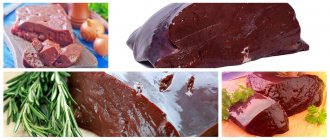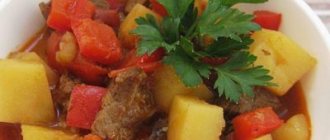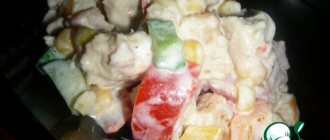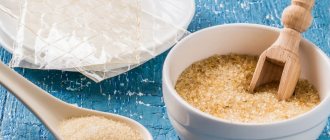Harm to jelly
The presence of artificial components in the jelly determines the harm of this product. Its use in this form can lead to allergies, in particular, skin rashes, itching, etc.
| Product | Kcal | Proteins, g | Fats, g | Angle, g |
| Jelly with fresh and canned fruits | 53,7 | 2,1 | 0,1 | 11,7 |
| Meat or fish jelly | 140 | 21,7 | 5,7 | 0,6 |
| Jelly from fruit or berry extract, or from natural fruit or berry juice (juice) | 82,3 | 2,7 | 0,1 | 18,9 |
| Cream jelly | 249 | 6,4 | 12 | 30,9 |
| Jelly from fruit or berry syrup | 10,5 | 2,6 | 0,01 | 0,02 |
| Jelly from fresh fruits or berries | 69,1 | 2,5 | 0,04 | 15,6 |
| Milk jelly | 192,1 | 6,3 | 11,1 | 17,9 |
| Jelly from lemons, oranges, tangerines (lemon) | 69,4 | 2,6 | 0,03 | 15,6 |
| Kishmish jelly | 247 | 65,9 | ||
| Crowberry jelly | 67,4 | 2,6 | 0,01 | 15,1 |
| Barberry jelly | 218,3 | 58,2 | ||
| Galaretka | 373 | 10,1 | 0 | 87,6 |
| Jelly for cake | 87,6 | 2,8 | 0,02 | 20,3 |
| Apple jelly | 69,1 | 2,5 | 0,04 | 15,6 |
| Curd jelly | 165 | 9,864 | 6,866 | 15,268 |
| Lemon jelly | 87,6 | 2,8 | 0,02 | 20,3 |
| Milk jelly | 31,8 | 2,717 | 1,237 | 2,375 |
| Kiwi jelly | 69,1 | 2,5 | 0,04 | 15,6 |
| Cherry jelly | 56 | 2,8 | 0,02 | 14 |
Jelly is a favorite treat for those watching their weight. It is voluminous, perfectly satiating and at the same time has a moderate calorie content. Of course, it all depends on what products were used in the process of making the jelly. In this article we will give an average description of jelly and several recipes for its preparation.
The history of jelly
Jelly is highly prized in Jewish culture. It is called “neither fish nor meat” and is considered a kosher dish. But such a judgment can be considered dubious if you take a closer look at where it came from and what products were originally used for its preparation.
The first mention of this dessert dates back to the 14-15th century. It was then that people first began to eat a dish reminiscent of modern jelly. It had a milky color, a sticky consistency, and was made from meat products and sturgeon bladders.
In the Middle Ages, nutritious types of jellies were especially popular - based on fish and meat. The former were prepared from fish entrails, and the latter from pig ears. The ingredients were cooked for a long time and the product was of an unusual color with an unpleasant odor.
Historians say that Napoleon and Josephine loved to treat themselves to delicacies made from fruits. It was very popular among men of that time because it was believed that its individual components had a positive effect on male strength.
Already in the 21st century, they began to prepare desserts based on gelatin, pectin and agar. Its consistency is familiar to modern man.
But the real heyday of the dish occurred in the United States. This is where this dessert is especially popular.
Engineer Perp Waite from America added dyes and flavors to the colorless and odorless powder and got an amazing purple dish. But his brainchild did not bring him any income, and he sold his patent. The dessert's popularity was saved when gelatin was advertised in the 20th century.
It was after adding gelatin to the recipe that the product became popular and is still a hallmark of the American national cuisine.
General definition and benefits of jelly. Average calorie content
This is a food product that has a gelatinous consistency. It is achieved through additives such as agar-agar, gelatin, pectin. Thanks to the fiber content, it saturates well without leaving any heaviness. By default it is considered a dessert, but it can be unsweetened, for example, aspic.
By and large, the dish consists of 2 elements: liquid (juice, broth, broth, etc.) and directly. If the latter is used of plant origin (agar-agar, pectin), then the treat can be included in the menu of vegetarians and vegans.
As mentioned above, no matter how you prepare the jelly, the calorie content is obtained by summing the energy value of all the products used. For example, if the jelly is based on very tasty, but at the same time very fatty cream 33%, then it will be difficult to call this treat dietary.
On average, calorie content is approximately 70 kcal per 100 grams. This is provided that mainly fruit juices and decoctions are used.
Homemade jelly is a very healthy dish. Moreover, depending on what binder was used, the practical properties change:
- pectin has a beneficial effect on the digestion process and cleanses the intestines;
- agar-agar is practically not absorbed and also promotes cleansing;
- gelatin has a beneficial effect on joints.
At what age can jelly be given to a child?
Jelly is a delicious dessert, but it is better to give it to a child from 1.5 years old. It is better to prepare it yourself using natural products. In addition, for children under 3 years of age it is better to make it using pectin or agar, because these gelling substances are of plant origin.
Important! You should not give your child jelly in bags; there is no benefit from it.
It often contains flavorings and dyes that negatively affect the development of the child's body.
We recommend reading: What is tahini: composition, how the paste is useful, how to use it, harm
Are we ready?
Soak gelatin in 150 ml of apple juice and let it swell.
Combine raspberries, remaining apple juice, sugar and basil. Place over low heat and bring to a boil, stirring constantly. The sugar should completely dissolve.
Strain the mixture through a sieve. Press lightly to squeeze out all the juice from the raspberries. Return to heat and add soaked gelatin.
Stir thoroughly and remove from heat, avoiding boiling.
Pour the mixture into bowls and refrigerate until completely set.
Blueberry-lemon jelly on agar
A wonderful dish with sourness and rich berry flavor. All products of plant origin can be included in the menu for people who do not eat products of animal origin:
- blueberries - 400 grams;
- lemon juice - 100 grams;
- chopped lemon zest from 2 lemons;
- agar-agar - 6 grams;
- water - 600 grams;
- sugar - 100 grams.
This blueberry-lemon jelly has calorie content, proteins/fats/carbohydrates per 100 grams: 57 kcal, proteins/fats/carbohydrates - 0.5/0/13.7.
Composition of jelly
The beneficial properties of the jelly are due to its unique composition. The natural product contains only two ingredients - fruit nectar and gelatin. That is why the finished jelly is enriched with vitamins and minerals that are part of the berries from which the juice is prepared. So, for example, if fresh cherries were used, then the product is saturated with vitamins C, A and D, dietary fiber and organic acids.
We recommend reading: Crackers: health benefits and harms
Gelatin is pure collagen or animal protein. Serves as a thickener.
Preparation
Rub the lemon zest with half the sugar with your fingers. This measure will provide you with a more flavorful dish.
Add the sugar-lemon mixture to 400 grams of water, bring to a boil over low heat and strain.
Mix the other half of the sugar with agar-agar. Add the resulting mixture to the remaining water and bring to a boil. Cook, stirring constantly, for a minute.
Combine the agar mixture and stir until smooth.
Evenly place pre-washed and dried blueberries into 4 bowls for jelly. The number of berries will not increase the calorie content, but the taste will be more intense.
Cool the lemon mixture slightly so that it does not scald the berries, and coat the blueberries evenly with it.
Place the bowls in the refrigerator and wait until they completely harden.
This recipe is quite versatile - you can use any fruit and flavorings for the syrup, each time getting a new complete dish.
Cool the treat completely before serving. Its calorie content, of course, will change if you add whipped cream when serving, but the taste will be richer.
Jelly
- this is a very tasty and healthy product, the use of which helps the growth of nails, hair, and gives youth to the skin, due to the high content of collagen - a protein for human connective tissue. How many calories are in jelly
It’s easy to find out the calorie content of jelly if you buy it in industrial bags. Both calories and energy value are listed on the packaging. For homemade jelly, you need to calculate the calorie content yourself, taking into account how much sugar there will be in the dessert, or what it is made from. Fruit jelly, which you prepare yourself, will have a calorie content of 100-150 per 100g. product. Depends on the fruits you use and the presence of sugar in them.
A banana has more calories than an orange or cherry. A banana has 91 calories, an orange has 38, a cherry has 53 calories, and a lemon is ideal for jelly, with only 31 calories. Calorie content of lemon jelly is 86 calories. When using canned fruits, the calorie content increases significantly due to the sugar added to the fruit. But you need to be more careful with dried fruits - they are very high in calories, and are not very suitable for making jelly, as they will greatly increase the number of calories in it. Chocolate and milk jellies will be higher in calories than fruit jellies. Gelatin and its beneficial properties
Gelatin itself is high in calories, it contains 355 calories per 100g. But this does not apply to the calorie content of the jelly, since 15 grams are needed for 1 liter of juice. gelatin.
Gelatin is a healthy product. With frequent consumption of dishes containing gelatin, and this is not only jelly, but also jellied meat, the body is enriched with collagen and lecithin, which are responsible for youthful skin and accelerate the growth of nails and hair. And for women, these criteria are very important, which means you need to include jelly in your diet more often. This will not make you gain weight, but it will help improve your appearance. Gelatin is also useful for people who have problems with joints - consumption of gelatin increases the amount of lubricating fluid in the joints. Jelly on the child's menu
Jelly must be present in a child’s diet, especially since many children simply adore it! You just need to decorate it beautifully: in multi-colored layers, with pieces of fruit inside, in the form of broken glass.
Berry jellies.
Jelly is prepared from water, sugar and gelatin (usually about 50 g of gelatin per 1 liter), as well as from fresh berries and fruits; berry juices, syrups, milk and other products. For flavoring, vanilla sugar, citrus zest, citric acid, wines, and liqueurs are added. The gelatin is soaked in plenty of cold water, and when it swells (after about an hour), the excess water is drained and the gelatin is added to the boiling syrup with continuous stirring. When the gelatin is completely dissolved, the jelly is ready. It is poured into molds and placed in a cold place to harden. To remove the jelly from the mold, immerse it in hot water for a few seconds, ensuring that no water gets on the jelly. Jelly intended for filling flour confectionery products is cooled to a viscous state, and the products are poured in a cool place.
Berry jelly.
Ingredients:
725 g juice - 100 g granulated sugar - 100 g white wine - 8 g gelatin - 1/4 lemon.
Preparation.
Squeeze juice from berries (raspberries, strawberries, currants), add sugar, white wine, lemon juice and boil. Then pour in the gelatin, previously soaked in cold water and dissolved, mix well, pour into molds and place in a cold place to cool. Before laying out the jelly, lower the mold into hot water for a few seconds, slightly detach the jelly from the edge of the mold and place in a bowl. Served in a bowl.
Pour the jelly into the mold, let it harden in the refrigerator, then very briefly, for 1-2 seconds, dip the mold in hot water and carefully tip it onto a dish.
Berry jelly.
Ingredients:
1 cup berries - 3 cups water - 0.5 cup sugar - 2 tbsp. l. gelatin - 1 g citric acid.
Preparation.
Soak gelatin for 1.5 hours in cold water at the rate of 1 tbsp. l. gelatin per 0.5 cup of water. Wash the berries (cranberries, raspberries, currants, etc.) and squeeze out the juice. Pour hot water over the pulp and boil for 5-6 minutes. Strain the broth, add sugar, citric acid, bring to a boil, remove the foam, add the prepared swollen gelatin, stir until it dissolves. Bring to a boil again, pour in the berry juice, stir, pour into molds and cool. Before serving, immerse the jelly mold 2/3 full in hot water, shake and place on a plate or in a bowl.
Forest berry jelly.
Ingredients:
250 g of any berries - 250 g of water - 50 g of sugar - 10 g of gelatin - sour cream.
Preparation:
Sort out ripe berries (wild strawberries, wild raspberries, blueberries, blackberries, blueberries, lingonberries), rinse, squeeze out the juice through cheesecloth, and put it in the cold. Pour boiling water over the squeezed pulp and cook for 5 minutes, then strain, add sugar, gelatin and berry juice soaked in a small amount of water, stir. When the gelatin is completely dissolved, strain again, pour into molds or bowls moistened with cold water, and refrigerate. Before serving, garnish with whipped sour cream and fresh berries. With uncooled jelly, you can decorate the top of the cake, pour over fresh fruits or berries and serve them on a platter.
Raspberry jelly.
Ingredients:
200 g raspberries - 140 g sugar - 10 g gelatin - 40 g dry wine - 160 g water - 30 g cream - 10 g sugar for cream.
Preparation.
Mash the raspberries, add water and rub through a sieve. Boil the resulting juice with sugar, add pre-soaked gelatin, mix everything, strain, pour in dry white wine, pour into molds and put in a cool place. Served in bowls, decorated with whipped cream and sugar.
Jelly in orange peel halves.
Preparation:
Take 3 oranges, 10 g gelatin, 100 g sugar, 1 bag of vanilla sugar.
Wash the oranges, cut them in half from pole to pole, and scoop out the pulp with a spoon.
Squeeze the juice out of it and add sugar and vanilla sugar. Soak gelatin in half a glass of cold boiled water.
When the gelatin swells, heat it in a water bath until dissolved and pour it into the heated orange juice. To fill 6 orange peels you need about 500 ml of liquid, so you can add water to the gelatin mixture to obtain the required amount. For stability, place the orange peels in a muffin tin and pour the prepared slightly cooled orange mixture into them.
Place in the refrigerator to harden. After the jelly has hardened, remove it from the refrigerator.
After hardening, the jelly in the orange peel halves can be cut into slices. Heat a very sharp knife in hot water before cutting.
Jelly in watermelon or melon slices.
Here's a cute jelly you can make using watermelon or melon rind as a mold. To find out how much jelly is needed for half a watermelon or melon, you need to count how many glasses of water fit into the scraped out rind. When it hardens, cut the jelly watermelon into slices. It turned out beautifully and the jelly holds tightly in the slices.
BON APPETIT!
Today, jelly does not lose popularity. The undying love for this dessert exists not only because of its taste, but also because of the beneficial properties it contains. The word jelly comes from France. Local chefs used this word to call frozen desserts of fruit juice or broth - today's jellied meat.
At home, you can make jelly even without. Instead, use pectin or agar-agar. Agar-agar is an extract from seaweed. This ingredient contains a large amount of polysaccharides. In jelly using agar-agar, unlike gelatin, you can even add pieces of fruit.
Today, jelly amazes with the variety of its taste. It can be fruit, milk, sour cream, coffee, tea and others.
How many calories are in jelly?
It turns out that you can safely include jelly in the diet of a person on a diet, since the calorie content of jelly is only 80 kcal per 100 g.
Calorie content of fruit jelly
According to the classic recipe, jelly is prepared from fresh or frozen fruits or from syrups made from various fruits. Fruit jelly is low in calories and contains only 87-98 kcal per 100 g. Despite the low calorie content, fruit jelly contains a fairly large amount of protein.
Calorie content of milk jelly
Milk jelly will not leave anyone indifferent. It just melts in your mouth. Milk jelly is even lower in calories than fruit jelly. Just 62 kcal can raise a spoiled diet. For those who like a brighter taste, you can add your favorite fruits to it.
Calorie content of sour cream jelly
The calorie content of sour cream jelly will be higher than milk or fruit jelly. Most recipes use 10% fat sour cream. Therefore, the calorie content of sour cream jelly reaches 140 kcal per 100 g of finished product.
Let's talk about the benefits of gelatin - a healthy food product available all year round, especially for people who want to lose weight. Recently there has been a lot of talk about gelatin, both perception and complete denial of the product, its benefits and harm to the body. Let's try to figure it out.
Calorie content of boiled beef tongue. Calorie content of various tongue dishes
It depends on many factors that a person cannot influence. In particular, a direct relationship is observed between the calorie content of the offal and the fatness of the animal of which it was a part during its lifetime. But there are factors that can be influenced. For example, you can choose the most dietary method for preparing offal, which will suit you with its performance.
For example, if you take beef tongue, then in one hundred grams of boiled product there are about 175 calories. By the way, if you buy veal tongue rather than beef tongue and boil it, you can gain a little in terms of calorie content of the dish. There are about 163 calories in one hundred grams.
If the beef offal is cooked in jelly, that is, made as jellied, then the numbers will increase to 208–210 calories per hundred grams. But the lowest calorie content is demonstrated by the grilled delicacy. In this case, there are 140 calories per 100-gram serving.
The caloric content of pork tongue will be much higher. If you boil it, then a hundred grams of food will contain about 185 calories. Although it must be admitted that when boiled, the offal loses about 20% of its calorie content. Indeed, in its raw form, the indicators reach 210 calories per hundred grams.
This figure is even higher for a rarer delicacy - lamb. Gourmets love it very much, because they know that lamb tongue tastes much more delicate than beef or pork. But its calorie content is the highest and reaches 223–225 calories per hundred grams (in raw form).
If you boil it, then the figure for a 100-gram serving will drop to 195 calories.
More complex dishes in terms of recipes show different caloric content. For example, for beef and pork tongue baked in the oven, it is about 230 calories per hundred grams. But if you stew beef offal with sour cream, the calorie content of the dish will be 235 cal.
For pork tongue stewed in sour cream, the figure is slightly higher and reaches 245 calories. There are also recipes for boiled and smoked pork tongue. The calorie content of this delicacy is 206. At the same time, simply smoked offal has an indicator of 255 calories per hundred grams.
It is quite difficult to judge the calorie content of fried tongue, since this delicacy has a delicate structure, and no one dares to spoil it in a frying pan by making it coarser.
How much does beef tongue cost?
Beef tongue is a meat delicacy, famous for its soft structure and delicate taste. Served as a separate dish, and also included in sausages and canned food. Having considered how much beef tongue costs, the following figures were highlighted:
A complete answer to this question can be obtained by reading:
Price of beef tongue in different establishments
- farm land. Private and small companies cut out the exquisite part themselves, selling it separately from the other parts. In this case, a natural and fresh product will be provided at a price of 867 rubles per 1 kg. The pieces come whole, and the weight of one copy reaches 800-900 grams. When ordering a large batch (8-10 kg), you can reduce the starting rate by 10-15%. You can find these enterprises in Moscow in nearby villages;
- the shops. Rarely found on sale, only in large hypermarkets in frozen form. Placed on shelves in plastic boxes wrapped in cellophane to protect them from weathering. In stores in the capital and St. Petersburg they sell for 597-609 rubles/kg;
- markets. Here, beef tongue is displayed for sale in the meat department along with other delicacies. The cost is 784 rubles/kg, and when choosing, you must carefully inspect the product and choose the freshest one. If we are talking about a deal for 2-3 kg, then you can achieve a discount of 5-10% by bargaining;
- restaurants. Dishes are presented in the form of stewed tongue with vegetables (on the menu 450-470 rubles/serving). An option is also possible in the form of slicing with sauce in a salad, in the form of a jellied dish, which will cost 460-490 rubles/portion.
Deciding how much beef tongue costs will help those who are planning to buy this delicacy to navigate the market.
Cost of self-cooking
Among the huge number of recipes for preparing beef tongue, we will consider the most popular and simple one, for which you will need:
- Beef tongue 1 kg: 600 rubles;
- Carrots 100 gr: 8 rubles;
- Bay leaf: 5-10 rubles;
- Onion 2 heads: 7 rubles;
- Pepper and salt: free.
The process itself is represented by the following points:
- pre-soak (about 30 minutes);
- clean from visible contaminants. Scrape off the dirt with a knife;
- rinse well with cold water;
- Dip your tongue into boiling water. Cook until it boils again;
- remove foam during cooking;
- cook for 15 minutes. Drain the water;
- again lower the tongue into boiling water (refilled). We are waiting for it to boil. Cook until fully cooked;
- A couple of hours before it’s ready, add salt to the broth. Throw in spices, herbs, carrots (whole);
- remove from boiling water and place in a container of cold water for a couple of minutes (the skin will come off easier);
- tongue is ready. Can be used as an appetizer, added to salads, prepared aspic, or decorated with sandwiches.
Using this data, it becomes clear that the price of beef tongue is 625 rubles if you cook it at home.
Beef tongue calorie content proteins fats carbohydrates. The calorie content of beef tongue is 146 kcal per 100 grams of product
Proteins account for 12 g, fats – 10.1 g, carbohydrates – 0.0 g.
What is the calorie content of beef tongue cooked in different ways? And here it is:
Beef tongue poisoning. Rotten meat poisoning
At high storage temperatures, a faulty freezer, or prolonged exposure to the counter during the hot season, the processes of decomposition of muscle tissue begin.
The appearance of the meat becomes dirty-gray with a characteristic putrefactive odor and the overlay of fibrin or mucus. The piece is loose and falls apart when cut.
Rotting begins with massive contamination of the meat product with E. coli or staphylococcus.
Once in the body, bacteria and their toxins cause reactive inflammation of the gastric and intestinal mucosa and general intoxication.
Symptoms of meat poisoning:
- pain and cramping in the upper abdomen appear 1–3 hours after eating rotten meat;
- repeated vomiting, severe nausea, belching of air and food;
- diarrhea (may or may not);
- the increase in body temperature is caused by the entry of the toxin into the blood and its effect on the thermoregulation center.
Additionally, all signs of intoxication are identified: headache, dizziness, tachycardia, symptoms of dehydration, dry mouth.
Salmonellosis
Poisoning from the meat of an animal with salmonellosis is not so rare. The incubation period lasts on average up to a day. Poisoning with gastrointestinal syndrome manifests itself:
- stomach pain;
- vomit;
- loose, watery stools, sometimes mixed with blood;
- high body temperature (up to 40 °C);
- headache up to lethargy.
Salmonellosis poses a great danger in terms of dehydration. With untimely treatment, generalization of the process, sepsis and death are possible. At the initial stage of the development of poisoning, only laboratory examination of the patient’s secretions can distinguish a staphylococcal infection from salmonella.
Botulism
Botulism is perhaps the most dangerous of all types of infections that get into meat products.
The clinical picture of botulinum toxin poisoning is not difficult.
Symptoms of poisoning from meat containing botulism infection occur after a few hours and are characterized by weakness in all muscle groups, visual disturbances (double vision, convergence disorder, retina, etc.)
d.), respiratory failure until it stops. Patients cannot swallow food, water and saliva, and they choke on vomit.
The prognosis in the absence of treatment is extremely unfavorable.
Typhoid and paratyphoid
Another of the most dangerous abdominal infections that affects the intestinal lymphatic system. Contamination of meat occurs from a sick person if sanitary standards are not observed. The incubation period is very long (up to a month), so it is not possible to assume a connection between the disease and meat consumption.
Signs increase gradually. First, the lymph nodes of the small intestine, liver and spleen enlarge, leading to abdominal pain. After the addition of bacteremia, a rash appears on the body, severe headaches, fever with chills, lethargy, and delirium. Various complications often occur: meningitis, bacterial endocarditis, arthritis.
The diagnosis of typhus or paratyphoid is confirmed by a laboratory blood test for specific antibodies.
Source: https://zdorovaya-eda.com/recepty/kaloriynost-otvarnogo-govyazhego-yazyka-kaloriynost-razlichnyh-blyud-iz-yazyka
What is food gelatin made from?
Gelatin
is a hydrolyzed collagen protein, a natural product, most often extracted from connective tissue, tendons and bones of animals by denaturation. The product is widely used in the food industry, building materials industry and pharmacology.
The origin of the name gelatin comes from the French female name gélatine
(frozen, frozen)
-
Jella.
There is a version that Peter Cooper, who discovered this product, named it in honor of the woman he loved. This is one of the versions. Not all gelatin is made from animal products; you can get a product from algae (agar-agar) and pectin found in vegetables and fruits. Agar-agar
contains a lot of magnesium, which has a beneficial effect on the condition of blood vessels.
Gelatin, obtained from plant pectin
, is less useful in its composition, however, it perfectly removes radiation from the body and is good for that.
The attitude towards gelatin has always been ambiguous, given the technology of its production - somewhat negative, but due to its natural origin, gelatin is recognized as a very useful product for human health. True, there is still debate about its benefits for restoring joints and ligaments, as well as chondroprotectors. But there are living witnesses who have been convinced more than once that their health has improved with the constant consumption of products with gelatin.
To improve the condition of cartilage and ligaments, the consumption rate is 10 grams of gelatin dry matter per day.
. To prevent diseases, 2-3 grams per day is enough and just eat foods that contain a lot of gelatin more often.
So what kind of product is gelatin? And what is its benefit?
Consumption standards and possible harm from the product
Nutritionists often recommend including the tongue in therapeutic and health menus, as well as in low-carbohydrate or protein diets. True, you can eat it no more than twice a week, since the fat content of the product is quite high. And the daily consumption rate should not exceed 150 grams. It should be noted that already half of this amount will one hundred percent replenish the body’s needs for vitamin B12. It, in turn, helps maintain the normal functioning of fat and carbohydrate metabolism. Of the microelements, this dietary product contains the most zinc. Literally one hundred grams of the delicacy contains more than 40% of the daily requirement of this microelement necessary for human health.
At the same time, there are several contraindications to using the tongue. In particular, some people who have an individual intolerance to this product are better off without the delicacy in their menu. Its use will also be harmful for people suffering from bronchial asthma. The taboo is due to the fact that the offal is quite fatty. For the same reason, you should not abuse this dish, as the load on the liver and kidneys will increase, which in turn can negatively affect your immunity.
Elderly people should be especially careful about the amount of offal they consume.
Composition and calorie content of gelatin
Gelatin is 86% protein
, and it contains absolutely no carbohydrates. This composition makes it healthy.
In addition, gelatin contains amino acids such as glycine, lysine and proline,
which are necessary for the body to synthesize connective tissue, ensure brain function, relieve nervous tension, etc.
Main microelements: phosphorus, iron,
contained in gelatin always add benefits to the product.
Calorie content of gelatin is 350 kcal. per 100 grams of product
. Of course, this is a lot, but considering that gelatin is added to dishes in microdoses, this is quite a bit.
So the calorie content of fruit jelly is so low, only 80-90 kcal.
Beef tongue: benefits and harms, calorie content, recipes with photos step by step
The benefits and harms of beef tongue have been studied by scientists for a long time, so they are not questioned. This product is a meat delicacy valued by gourmets and doctors. Beef tongue not only has a delicate taste and beneficial nutritional properties. It can also serve as an excellent substitute for sausage and other smoked meat products.
Chemical composition of beef tongue
Beef tongue is a unique product. It has a number of properties that are necessary and useful to us. In tsarist times, okroshka was always cooked using it. After all, it is a rich source of healthy protein, which also has an excellent taste.
| Calorie content (kcal) | 175 |
| Cholesterol (mg) | 150 |
| Water | 69,0 |
| B(g) | 16,2 |
| F (g) | 12,0 |
| U(g) | 2,3 |
Vitamin-mineral complex:
| Vitamins: | |
| B2 (mg) | 0,32 |
| B5 (mg) | 1,99 |
| B12 (mcg) | 4,75 |
| PP (mg) | 7,6 |
| Macro- and microelements: | |
| Zinc (mg) | 4,85 |
| Chromium (mcg) | 19,2 |
| Molybdenum (µg) | 16,1 |
| Iron (mg) | 4,2 |
| Chlorine (mg) | 250,5 |
| Phosphorus (mg) | 223,3 |
| Potassium (mg) | 254,5 |
Essential amino acids:
| Phenylalanine + Tyrosine (g) | 1,19 |
| Tryptophan (g) | 0,19 |
| Threonine (g) | 0,72 |
| Methionine + Cysteine (g) | 0,65 |
| Lysine (g) | 1,37 |
| Leucine (g) | 1,23 |
| Isoleucine (g) | 0,78 |
| Histidine (g) | 0,61 |
| Valin (g) | 0,86 |
We should probably return to the traditions of our ancestors.
After all, there is so much in the sausage that is produced today! A whole set of additives with toxic properties: sodium nitrite, flavorings, flavor enhancers, monosodium glutamate, leather, soy, cartilage! They make okroshka harmful and make it a dangerous product for health. Isn't it better to cook the dish in the old traditional way with beef tongue, the properties of which are undoubtedly beneficial?
Nutritional value and calorie content of beef tongue
The structure of the offal is muscle tissue, covered on top with a dense, rough shell. Weight can reach 2.5 kilograms.
Its main valuable properties are its high content of healthy protein, which is also easily digestible. The offal does not contain connective tissue, lymph nodes, or fat.
All this is carefully removed before it goes on the counter, since it only causes harm to the human body.
The calorie content of boiled beef tongue per 100 grams is small: only 175 kcal. For its delicate and refined taste and valuable nutritional properties, it is valued by chefs from many countries around the world. Snacks, jellies, salads and other healthy dishes are prepared from the offal.
Useful properties of beef tongue
The value of the by-product is explained by its composition. Due to the rare beneficial compounds in its composition, it is able to restore the chemical balance in the body, which ensures good health and a strong immune system.
Beef tongue is a rich source of healthy, easily digestible protein, which makes it a dietary product.
It also contains a significant amount of iron, which ensures the exchange of oxygen between internal organs and the environment.
In addition, it contains vitamin B12, a deficiency of which can cause irreparable harm to the hematopoietic system in the human body.
There is zinc, thanks to the properties of which our sex hormones and pituitary gland function fully. There is nicotinic acid (NA), a deficiency of which in the body stops properly synthesizing our main energy substance - ATP, which, accordingly, causes harm to the body: dermatitis, dementia or diarrhea occurs and, as a result, insufficiency of the gastrointestinal mucosa.
Benefits of beef tongue for women
For the better half, the offal will help improve the properties of the skin, maintain a girlish figure and achieve a smooth, calm state of the nervous system, and a restful sleep. Active compounds renew and regenerate skin cells from the inside, preventing them from losing their elasticity and freshness.
Source: https://poleznii-site.ru/pitanie/myaso-i-ryba/chem-polezen-govyazhiy-yazyk.html
What are the benefits of gelatin for the body?
- Gelatin is involved in the synthesis of collagen in the body and connective tissue. Its presence leads to restoration of the body and improvement of the condition of all organs.
- It is extremely necessary for joints, ligaments, and tendons. Therefore, it is useful for people suffering from joint diseases, osteochondrosis, and injuries to ligaments and tendons.
- To enhance muscle growth, gelatin is useful as a product containing protein.
- Gelatin is an excellent blood clot, so it is recommended for those suffering from this problem, as well as for vascular rosacea and spider veins.
- Dishes using gelatin are good for the stomach, ensuring good digestibility and absorption of food. By enveloping its walls, jelly products relieve pain due to stomach diseases. Due to its lightness, jelly is allowed as the first food for a patient after surgery.
Gelatin for weight loss
All jelly-like products are useful: mousse, marmalade, jellied meat, aspic, jelly, especially fruit and berry products made from natural fruit and berry juices, the calorie content of which does not exceed 80-90 kcal per 100 grams of product. So for people trying to normalize weight and dieting, products with gelatin are very welcome. You can eat them as much as you like without restrictions, as long as you don’t add sugar. These delicious treats are easy to prepare at home using natural juice and fruits.
Gelatin for ligaments and joints
The benefits of gelatin for the elasticity of ligaments, cartilage, and to maintain natural lubrication of joints have been scientifically proven. All you need is gelatin! A simple and cheap ingredient that is available to everyone. It is only important to consume foods with it daily:
The recipe is simple:
In the evening, soak 5 grams of dry gelatin in 50 g of water and leave it to swell overnight. In the morning, add any drink that you are used to drinking at breakfast to the swollen gelatin. Be it yogurt, milk or tea and eat it. After a while, you can have a more calorie-rich breakfast.
Within a week you will feel how much your well-being will improve. The usual course of treatment is 30 days. After half a year, it is recommended to repeat the treatment.
Jelly recipe:
1 tbsp. Pour a spoonful of dry gelatin into a glass of boiled water and let stand until completely swollen. Heat to a boil, but do not boil, and add 1-2 glasses of natural fruit or berry juice, or rosehip syrup (the same essential vitamin C), you can add pieces of fruit, candied fruits, and berries. Pour into molds. Tasty and healthy!
As you can see, the benefits of gelatin and products containing it are considerable. However, there is one subtlety: the absorption of gelatin
from food is possible only if the body is fully supplied
with vitamins,
especially
“C” and bioflavonoids
(rutin, quercetin, hesperidin and catechin from light yellow-green and colorless plants).
Otherwise, all the benefits of food containing gelatin will be reduced to zero. At the same time, vitamins should be natural from vegetables, fruits, berries, and not their synthetic analogues.
This is where the dispute comes from: there is no evidence confirming the therapeutic effect of gelatin dishes. If there is a lack of vitamins in the body, do not expect any benefits!
Gelatin in cosmetology
Gelatin is widely used in cosmetology. As it contains collagen, it improves the condition of hair, nails, and skin. Masks with it even out the skin, making it firmer, reducing sagging and removing wrinkles. You can do them on the face, décolleté, and hands. It is important to keep the skin clean and avoid the eye area.
Recipe for a face mask (nourishing, moisturizing, toning, rejuvenating)
Soak 1 tablespoon of gelatin in 1/3 cup of water and let it soak. Heat to a boil, do not boil. Remove from heat, let it cool slightly, you can add any of the following products: cucumber juice, milk, kefir, activated carbon tablets, flour, oatmeal, strawberries, banana, cosmetic oil, glycerin, any product that has a beneficial effect on the skin and depending on what effect you want to achieve.
Apply with a warm brush to the face in 2-3 layers. Don't get up and stay calm. Exposure time is 20-30 minutes. Moisturize your face periodically. Rinse off first with warm, then cool water. You will see the effect of the mask on your face








